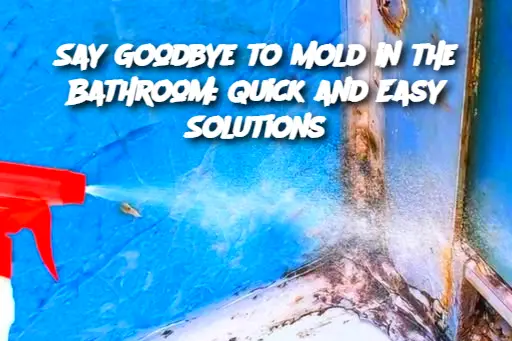Maintenance: Regularly clean your bathroom, focusing on areas that are prone to moisture buildup, such as the shower, bathtub, and sink. A quick wipe-down after each use can help minimize mold growth.
Storing Your Supplies: Keep your cleaning supplies, such as vinegar, baking soda, and hydrogen peroxide, in a cool, dry place. These ingredients are effective for many other cleaning tasks in addition to mold removal.
Variants:
Tea Tree Oil Solution: For those who prefer a natural, pleasant-smelling solution, tea tree oil is an effective mold deterrent. Mix 1 teaspoon of tea tree oil with 1 cup of water in a spray bottle. Shake well and spray onto moldy areas, letting it sit for 10-15 minutes before scrubbing.
Lemon and Baking Soda Paste: Lemon’s natural acidity can help remove mold and leave your bathroom smelling fresh. Combine lemon juice with baking soda to create a thick paste. Apply the paste to the moldy areas, let it sit for 10 minutes, and scrub away.
Bleach Solution (for Severe Cases): If the mold is extensive and persistent, a bleach solution (1 part bleach to 10 parts water) can be used to kill the mold. However, bleach should be used sparingly and with caution, as it can damage surfaces and is harsh on the environment.
Borax and Water: Borax is another powerful mold-fighting agent. Mix 1 cup of borax with 1 gallon of water and apply it to moldy areas. Scrub the surface and allow the solution to sit before rinsing off. Unlike bleach, borax is non-toxic and safer for regular use.
FAQ:
1. How can I prevent mold in the future?
To prevent mold, maintain proper ventilation in your bathroom. Always use an exhaust fan during and after showers, keep windows open when possible, and use a dehumidifier if needed to reduce humidity.
2. Can I remove mold from shower curtains?
Yes! Wash your shower curtain in hot water with vinegar or baking soda to help remove mold. If the mold is stubborn, soak the curtain in a mixture of vinegar and water for 1-2 hours before washing.
3. How often should I clean my bathroom to prevent mold?
It’s a good idea to clean high-moisture areas like the shower and sink once a week to prevent mold buildup. Regular maintenance ensures that mold doesn’t have a chance to thrive.
4. Is vinegar effective against all types of mold?
Vinegar is effective against most household mold, but it may not work on more severe infestations, especially those found on porous materials like wood. In such cases, consider using hydrogen peroxide or bleach.
5. How can I tell if mold is damaging my bathroom surfaces?
Mold growth can cause discoloration or staining on surfaces. If you notice that a surface is soft, discolored, or breaking down, it may indicate more serious mold damage that requires professional inspection and remediation.
Conclusion:
Mold in the bathroom is an annoying and potentially harmful problem, but with the right tools and techniques, you can quickly eliminate it and prevent it from returning. By using simple ingredients like vinegar, baking soda, and hydrogen peroxide, you can effectively remove mold and restore your bathroom to a clean, fresh state. With regular cleaning and proper ventilation, your bathroom can remain mold-free, ensuring a healthier environment for you and your family.
ADVERTISEMENT

